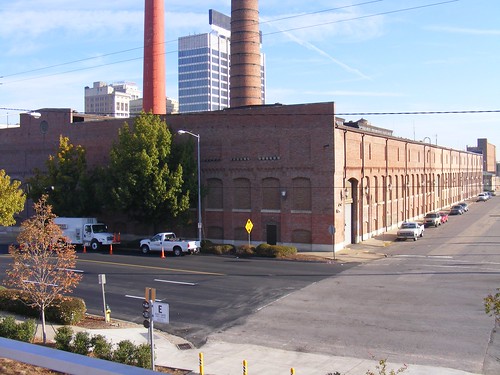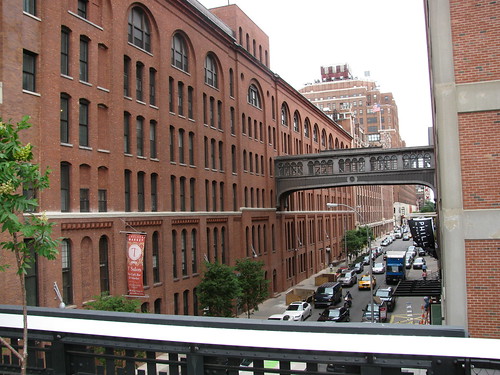STATIONMASTER’S NOTE: This piece was originally published on my personal blog, Dre’s Ramblings, in November 2010. While some things have changed, others have not – I’ve visited and enjoyed the High Line; Birmingham now has Regions Field downtown; and we’re about to see the long-awaited intermodal transit facility get built. It only seemed to make sense to republish the piece here as we begin to wonder about the potential future use of the Alabama Power steam plant as we begin the second half of 2013 – the original date given for the shut down of the facility.
-#-
 Apparently I’ve been thinking a lot about dreaming recently – see the last two posts if you don’t know what I’m talking about.
Apparently I’ve been thinking a lot about dreaming recently – see the last two posts if you don’t know what I’m talking about.
This week’s upcoming Food Summit‘s got farmers markets on my mind as well (or at least access to fresh food). So of course it means that I’ll want to do some dreaming about an potential farmers market situation for Birmingham…
The first real trip I ever made while working for Main Street Birmingham was to Baltimore, MD for the National Trust Main Streets Conference (next year’s conference will be in Des Moines, IA the 2014 conference is set for Detroit, MI and I’m already trying to figure out how I’m getting there). One of the things that stood out to me from the trip was how the various markets scattered throughout played an important role in the daily lives of those that lived close by. The ability to have access to fresh produce is immeasurable as are the social opportunities that occur naturally.
There are many people currently focused on the future of the area surrounding Railroad Park. They are particularly interested in how the area will change and what kind of energy and vitality will result from those changes.
The change of “for lease” signs to ones that read “available for redevelopment” is a dead giveaway. Then there’s the conversations taking currently taking place about the new ballpark slated for construction with rumors placing it to the immediate west of the park…
I’ve got my eye on the current Alabama Power steam plant located on Powell Avenue between 18th and 19th Sts. S. as a key to the surrounding area’s level of activity – as a farmers market. The photo at the top of this post shows the building as it looks from the pedestrian bridge on Railroad Park’s eastern edge.
Yes, I’m aware that there are some who view the space as a “cultural furnace” as discussed during the master planning phase of the park’s development. If it were to go in that direction it could possibly serve as a space that housed a satellite location for our museum of art and various other arts organizations.
It’s interesting to keep in mind though that Birmingham has become a home to an ever-growing foodie culture, supporting serving locally produced food. Several of those locally owned restaurants though are within walking distance of the park, including Brick & Tin, Trattoria Centrale and Cafe DuPont. Unless something’s changed recently, you’ve also got the planned second location for V. Richard’s slated for the ground floor of the Pizitz Building. Culinard‘s cafe is located a short stroll away at Innovation Depot.
The city also continues to lay the groundwork for emphasizing a healthier lifestyle – especially important considering that the state’s largest employer is currently a medical institution (as skillfully pointed out in today’s edition of The Birmingham News ).
 Organizations and efforts including Jones Valley Urban Farm, Champions for Health and the Southern Environmental Center‘s continuing ecoscape program also lend themselves to a community that could become well known for how they educate themselves and others about healthy lifestyles. Adding something like a farmers market to the area would provide even easier access to fresh produce for farmers and for those residents that will undoubtedly be moving into the area as condos and apartments begin to spring up.
Organizations and efforts including Jones Valley Urban Farm, Champions for Health and the Southern Environmental Center‘s continuing ecoscape program also lend themselves to a community that could become well known for how they educate themselves and others about healthy lifestyles. Adding something like a farmers market to the area would provide even easier access to fresh produce for farmers and for those residents that will undoubtedly be moving into the area as condos and apartments begin to spring up.
The image up at the top of the page reminds me of another view that I’ve yet to enjoy as of yet in person. The Chelsea Market serves as a destination along the completed portion of New York’s High Line Park. It serves as a successful adaptive reuse project in one of my hometown’s most energetic communities. Markets located in other cities (like Seattle’s and Philadelphia’s) tend to provide a venue for being social – in real life.
One thing for folks to keep in mind is that this should not prevent the creation of other permanent or temporary markets across the city. It really shouldn’t be a question of either/or at all. It should be a question of how to provide amenities to as many people as possible throughout the region, with this being one potential addition to a total solution.
It’s also important to note that Alabama Power has yet to actually give any public indication as to what their plans for the structure will be when it’s taken out of service in 2013. But it is important to start the public discourse from now so that when a decision is made, it is something that many will appreciate and benefit from.
It’d be nice to know what some of you think about it too…
Cheers.
Photos: Alabama Power Steam Plant. acnatta/Flickr; Chelsea Market From the High Line. edenpictures/Flickr.







Will Mercy be shown to Cooper Green?
It was coincidental was I was starting to think about what to write about the then pending vote about the future of Cooper Green Mercy Hospital. This is because both of my parents are retired registered nurses having served at two of New York City’s busiest public hospitals. (My mother worked at historic Harlem Hospital in their NICU for nearly two decades while Dad logged 30+ years of weekday evenings in Lincoln Hospital’s triage unit.)
As a result, you grow up hearing about babies born addicted to crack and seeing them about the size of your 10-year old hand. You realize your father doesn’t talk about work that much since, when he started, it wasn’t SoBro but the South Bronx before its transformation started.
They both asked the same question – What will happen to the patients?
It’s apparently a question that former Birmingham mayor Larry Langford pondered correctly back in 2009 – and one that seems to have not been thought through just yet. It’s a question many of us here in Jefferson County are wondering right now. It’s one without an answer – at least not one publicly shared as of yet. It doesn’t look like there’s been a plan introduced to anyone to explain how discontinuing inpatient care at the county hospital will be handled. It’s something you’d think would have already been shared before such a recommendation would be made. It was back on the August 28 agenda for the Jefferson County Commission though and it passed, 3-2.
There are other questions that needed to be answered before looking at the number of beds occupied – something else both of my parents immediately asked about since they both suggested it was an unfair number to use for such decisions – and making such a rash decision.
Can the inpatient services be absorbed by other area hospitals? There seems to be an assumption this can be done, though it doesn’t seem as though the other hospitals were talked to about it. There’s no doubt that some will look at UAB, University Hospital and its various other locations and its continuing expansion and renovation as a logical replacement though it’s a lot harder than you’d think. While there is a working relationship currently between the two entities, it is one grounded in education and not necessarily in management or operations.
Does this put the inpatient beds back in play? Barely mentioned in all of this is the fact that removing inpatient care from the list of services provided by Cooper Green could technically put those beds back into play. It could turn it into a much larger battle over who gets the right to expand and provide additional services to the community. This may include a digital hospital down along Highway 280 or, thinking outside the proverbial box, a new facility that may want to locate near a completed I-22 as people start to consider moving over there to “escape the city.” Before folks start saying it’s a business community push to see this happen, the August 10 statement from the Birmingham Business Alliance (PDF), paints a different picture and echoed requests to see a plan in place before this vote as well.
How will these patients get to and from their inpatient care? Quality transportation options, including mass transit, have been long talked about in this community without any sustained progress being made. We probably need to learn more about when or whether the long vacant executive director position at BJCTA will be filled (it still hasn’t been publicly listed) before we get a straight answer here. This type of conversation needs to be broad in reach and already happening before that person arrives. This becomes more significant since even if other facilities become options, the current hub and spoke bus system in place makes it much harder for some to access health care without a car.
We seem to have placed the cart before the horse with Tuesday morning’s vote. If there is any good news though, we now have a hard date set for these questions to be answered – December 1. If we haven’t dealt with them by then, we need to start thinking about how we truly prepare for progress to be made in metro Birmingham (maybe even in the hands of new caretakers come 2014).
André Natta is The Terminal’s stationmaster.
Leave a comment
Posted in Commentary, health
Tagged Cooper Green, healthcare, hospital, Jefferson County, options